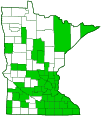spotted pink lady beetle
(Coleomegilla maculata)
Conservation • Description • Habitat • Ecology • Distribution • Taxonomy
Conservation Status |
|
|||||||
| IUCN Red List | not listed |
|||||||
| NatureServe | NNR - Unranked |
|||||||
| Minnesota | not listed |
|||||||
Description |
||
Spotted pink lady beetle is an elongated, pink, ladybird beetle. It is very common and widespread, probably the most common native lady beetle in eastern North America. The body is ⅛″ to ¼″ long, 3 ⁄32″ to ⅛″ wide, broadly oval, dome-shaped, and somewhat flattened above (dorsally). The head is black with a pink triangular mark on the upper part of the face (frons). The head is visible when viewed from above. The antennae are short and weakly clubbed. The plate covering the first segment of the thorax (pronotum) is pink with two large, triangular, black spots. The thick, hardened, shell-like forewings (elytra) are pink with ten black spots. They may appear red but closer examination shows the color to be darkish pink. The spots are in four rows in a 3-2-3-2 pattern. The spots in row 2 are large and undivided. The central (dorsal) spot in rows 1 and 3 are spread over the junction of the two elytra. When the elytra are separated the number of spots becomes twelve. The underside is flat and black except for the plate covering the first segment of the thorax (prosternum), and the lateral margin of the abdomen, both of which are pink. The legs are black. When viewed from above, the third leg segment (femur) is visible. There are two spurs at the end (apex) of the fourth leg segment (tibia) of the middle and hind legs. The larva looks like a tiny, blackish alligator with numerous spines and six legs. |
||
Size |
||
Total length: ⅛″ to ¼″ |
||
Similar Species |
||
Habitat |
||
Wherever plants that host their prey are found |
||
Ecology |
||
Season |
||
Two to five generations per year: early or mid-spring to fall |
||
Behavior |
||
|
||
Life Cycle |
||
Adults congregate in large numbers to overwinter in a protected area beneath leaf litter and stones, often near crop borders. They emerge in early to mid-spring. The female lays clusters of 8 to 15 eggs in a protected area on a leaf or stem near prey. Over the course of the season the female will lay between 200 and 1,000 eggs. Larvae moult three or four times before pupating. Three to twelve days later the adult emerges depending on the temperature. |
||
Larva Food |
||
|
||
Adult Food |
||
Plant pollen, aphids, adelgids, mites, insect eggs, and small insect larvae, including grain aphid (Acyrthosiphon dirhodum), pea aphid (Acyrthosiphon pisum), melon aphid (Aphis gossypii), dock aphid (Aphis rumicis), cabbage aphid (Brevicoryne brassicae), turnip aphid (Lipaphis erysimi), English grain aphid (Sitobion avenae), potato aphid (Macrosiphum euphorbiae), Nearctaphis crataegifoliae, lettuce root aphid (Pemphigus bursarius), pine bark adelgid (Pineus strobi). |
||
Distribution |
||||
|
Sources 7, 24, 27, 29, 30, 82. |
|||
| 10/9/2022 | ||||
Occurrence |
||||
Very common and widespread |
||||
Taxonomy |
|||
Order |
Coleoptera (Beetles) | ||
Suborder |
Polyphaga (Water, Rove, Scarab, Long-horned, Leaf, and Snout Beetles) | ||
Infraorder |
Cucujiformia | ||
Superfamily |
Coccinelloidea (lady, fungus, scavenger, and bark beetles) | ||
Family |
Coccinellidae (lady beetles) | ||
Subfamily |
Coccinellinae (common lady beetles) | ||
Tribe |
Coccinellini (black-spotted lady beetles) | ||
Genus |
Coleomegilla | ||
Subordinate Taxa |
|||
spotted pink lady beetle (Coleomegilla maculata fuscilabris) spotted pink lady beetle (Coleomegilla maculata lengi) spotted pink lady beetle (Coleomegilla maculata strenua) |
|||
Synonyms |
|||
|
|||
Common Names |
|||
pink spotted lady beetle pink spotted ladybird beetle pink-spotted lady beetle spotted lady beetle spotted pink lady beetle twelve-spotted lady beetle |
|||
Glossary
Elytra
The hardened or leathery forewings of beetles used to protect the fragile hindwings, which are used for flying. Singular: elytron.
Femur
On insects and arachnids, the third, largest, most robust segment of the leg, coming immediately before the tibia. On humans, the thigh bone.
Frons
The upper front part of an insect’s face, roughly corresponding to the forehead.
Pronotum
The exoskeletal plate on the upper side of the first segment of the thorax of an insect.
Tibia
The fourth segment of an insect leg, after the femur and before the tarsus (foot). The fifth segment of a spider leg or palp. Plural: tibiae.
What’s in a Name?
Beetles in the family Coccinellidae are commonly referred to as ladybugs. However, the term “bug” refers to insects in the order Heteroptera (True Bugs). The family Coccinellidae is in the order Coleoptera (Beetles). The term “lady beetle” is more precise than “ladybug”.
Visitor Photos |
|||||
Share your photo of this insect. |
|||||
| This button not working for you? Simply email us at info@MinnesotaSeasons.com. Attach one or more photos and, if you like, a caption. |
|||||
Babette Kis |
|||||
Coleomegilla maculata lengi spotted pink ladybeetle Coleomegilla maculata lengi spotted pink ladybeetle, hedgerow next to Barnes Prairie, Racine Co., WI photographed May 11, 2021 on Wake Robin, Trillium erectum. Also found on other spring ephemerals. |
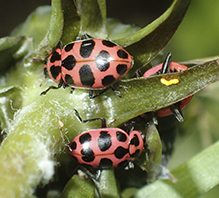 |
||||
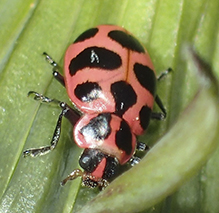 |
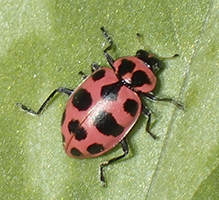 |
||||
Alfredo Colon |
|||||
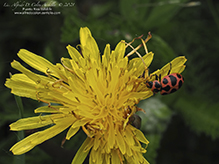 |
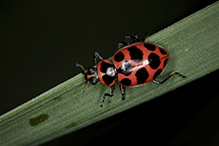 |
||||
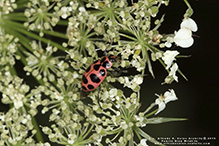 |
|||||
Molly and Robert Power |
|||||
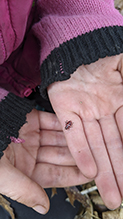 |
|||||
MinnesotaSeasons.com Photos |
|||||
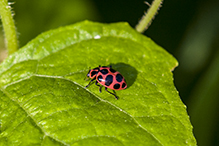 |
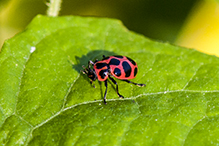 |
||||

Slideshows |
||

Visitor Videos |
|||
Share your video of this insect. |
|||
| This button not working for you? Simply email us at info@MinnesotaSeasons.com. Attach a video, a YouTube link, or a cloud storage link. |
|||
Other Videos |
|||
| Spotted lady beetle on garlic mustard Laura Elizabeth |
|||
About
Published on May 4, 2016 A native Wisconsin ladybug, Coleomegilla maculata (spotted ladybug beetle), on the invasive and very common Alliaria petiolata (garlic mustard) |
|||

Visitor Sightings |
|||||
Report a sighting of this insect. |
|||||
| This button not working for you? Simply email us at info@MinnesotaSeasons.com. Be sure to include a location. |
|||||
| Alfredo Colon 6/2/2021 |
Location: Woodbury, Minnesota |
||||
| Babette Kis 5/11/2021 |
Location: hedgerow next to Barnes Prairie, Racine Co., WI Coleomegilla maculata lengi spotted pink ladybeetle, hedgerow next to Barnes Prairie, Racine Co., WI photographed May 11, 2021 on Wake Robin, Trillium erectum. Also found on other spring ephemerals. |
||||
| Molly and Robert Power 4/11/2021 |
Location: Albany MN |
||||
| Alfredo Colon August 2019 |
Location: Slinger, Wisconsin |
||||
| Alfredo Colon 6/12/2018 |
Location: Woodbury, Minnesota |
||||
MinnesotaSeasons.com Sightings |
|||||

Last Updated:
